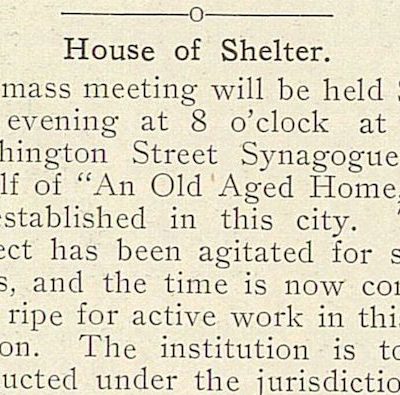
The Jewish Home for the Aged, also known by its Hebrew name Beth Moshab Z’Kainim, was a residential facility for older Jewish people in Western Pennsylvania. Efforts to create such a facility began in the early 20th century but failed to gain momentum until Rabbi Aaron Mordechai Ashinsky convened an organizational meeting on October 1, 1905 at the Beth Hamedrash Hagodol synagogue in the Hill District.[1]Home for the Aged organizational meeting announcement, Jewish Criterion, September 29, 1905 (online). [2]Home for the Aged organizational meeting report, Jewish Criterion, October 6, 1905 (online). By the end of the year, Rabbi Ashinsky and a team of supporters had purchased the “Jones Castle” and five acres of surrounding land on Breckenridge Avenue in the Hill District for $25,000 and had also launched a major fundraising campaign throughout the tri-state region around Pittsburgh, focusing especially on small towns in the area.[3]“Orthodox Jews to Conduct a Benevolent Institution Here,” Jewish Criterion, December 12, 1905 (online).
The Jewish Home for the Aged obtained a charter in January 1906 and dedicated its renovated building in late June 1906. Henry Jackson was the first president, and Rev. A. J. Newman was the first superintendent. The Jewish Home for the Aged was one of the initial beneficiaries of the Federation of the Jewish Philanthropies of Pittsburgh in 1912.
The original Jewish Home for the Aged facility had 18 rooms, a chapel, a dining hall, bathing facilities, a vegetable garden, and a barn with cows to supply fresh milk. Faced with ever-growing occupancy, Marks Browarsky underwrote a $30,000 addition to the building in 1910. The annex provided private rooms for married couples. Responding again to increased demand for rooms, a second addition onto the campus in 1920.[4]Feldman, Jacob. “The Jewish Experience in Western Pennsylvania,” Pittsburgh: Historical Society of Western Pennsylvania, 1986 (catalog record).
Over the next decade, as occupancy increased and the local Jewish population migrated away from the Hill District, the Jewish Home for the Aged launched a campaign to build a new $250,000 facility in the Browns Hill section of Squirrel Hill. The new home was dedicated September 10, 1933.[5]Jewish Home for the Aged dedication issue, Jewish Criterion, September 8, 1933 (online—Pittsburgh Jewish Newspaper Project). The Jewish Home for the Aged launched a major campaign in the early 1960s to increase the medical services available at the facility and eventually became known as the Jewish Home and Hospital for the Aged.[6]“The Course the Home Must Follow,” Jewish Chronicle, June 12, 1964 (online—Pittsburgh Jewish Newspaper Project). The name of the facility was changed in 1984 to the Riverview Center for Jewish Seniors.[7]“No more JHHA; now its RCJS,” Jewish Chronicle, September 20, 1984 (online). As part of a major expansion and reorganization in the 1990s, the Riverview Center joined several new Jewish elder care facilities to become part of the Jewish Association on Aging.
References
| ↑1 | Home for the Aged organizational meeting announcement, Jewish Criterion, September 29, 1905 (online). |
|---|---|
| ↑2 | Home for the Aged organizational meeting report, Jewish Criterion, October 6, 1905 (online). |
| ↑3 | “Orthodox Jews to Conduct a Benevolent Institution Here,” Jewish Criterion, December 12, 1905 (online). |
| ↑4 | Feldman, Jacob. “The Jewish Experience in Western Pennsylvania,” Pittsburgh: Historical Society of Western Pennsylvania, 1986 (catalog record). |
| ↑5 | Jewish Home for the Aged dedication issue, Jewish Criterion, September 8, 1933 (online—Pittsburgh Jewish Newspaper Project). |
| ↑6 | “The Course the Home Must Follow,” Jewish Chronicle, June 12, 1964 (online—Pittsburgh Jewish Newspaper Project). |
| ↑7 | “No more JHHA; now its RCJS,” Jewish Chronicle, September 20, 1984 (online). |